Notes: Two independent railway companies would vie to link Dudley with the national system in the mid-1840s, with the Oxford, Worcester & Wolverhampton Railway (OW&WR) heading north from Oxford to Wolverhampton and the South Staffordshire Railway (SSR) heading south-west from Walsall. Both companies were backed by two of the largest railway companies of the time: the Great Western Railway (GWR) and the London & North Western Railway (LNWR). A high-level meeting between the two in 1846 ended with a line of demarcation being drawn at Dudley with the LNWR stating it would push no further south and the GWR would not construct any lines heading in the Birmingham direction. Only time would tell if they would stick to their agreement.

The SSR was formed on 6 October 1846 with the merging of the South Staffordshire Junction Railway (SSJR) and the Trent Valley, Midlands & Grand Junction Railway (TVM&GJR). The SSJR had gained an Act of Parliament on 3 August 1846 for the construction of a line from Walsall to Dudley and the TVMGJR had gained a separate Act on the same day to construct a line from Walsall to Lichfield, so the merger of the two companies made perfect sense. The directors of the SSR were made up of three distinctive camps, the LNWR, The Midland Railway (MR) and independent directors; this was to have a bearing on future events. A clause inserted into the original Act stated if no train had run from Walsall to Dudley by 1 November 1849 then the rival Birmingham, Wolverhampton & Dudley Railway (BW&DR) would be given powers to reach Dudley from Swan Village. During construction of the line the BW&DR was vested in the GWR and this was to give the SSR added impetus to complete it on time. Construction of the line was running seriously behind schedule, and on 1 November 1849 a special train was run from Pleck (near Walsall) to Dudley along a route - on which stations and other infrastructure were far from .gif) complete - to a very temporary station: a wooden platform attached to a goods shed. This effectively removed the threat of the BW&DR being given running powers through to Dudley. Goods trains started to use the line on 1 March 1850, with passenger services beginning during May of the same year running to a temporary station near Dudley Castle. The ‘temporary’ station was to become permanent and was developed, by the LNWR, into the station which lasted into the 1960s. The line was leased to John Robinson McClean on 15 July 1850 for a period of 21 years; unusually this lease was completed by an Act of Parliament, the first time an Act was used in this way. McClean developed the lines’ interests to the north with entry gained into the prosperous Cannock coalfield. McClean terminated the lease after 11 years for reasons unknown and this left the LNWR and the MR to fight over ownership of the line; the LNWR won, leasing the line from 1 February 1861. complete - to a very temporary station: a wooden platform attached to a goods shed. This effectively removed the threat of the BW&DR being given running powers through to Dudley. Goods trains started to use the line on 1 March 1850, with passenger services beginning during May of the same year running to a temporary station near Dudley Castle. The ‘temporary’ station was to become permanent and was developed, by the LNWR, into the station which lasted into the 1960s. The line was leased to John Robinson McClean on 15 July 1850 for a period of 21 years; unusually this lease was completed by an Act of Parliament, the first time an Act was used in this way. McClean developed the lines’ interests to the north with entry gained into the prosperous Cannock coalfield. McClean terminated the lease after 11 years for reasons unknown and this left the LNWR and the MR to fight over ownership of the line; the LNWR won, leasing the line from 1 February 1861.
Construction of the OW&WR line was authorised by Act of Parliament on 7 August 1845 as an 89-mile mixed-gauge railway (7ft and 4ft 8½in) from Oxford to Wolverhampton via Worcester. The GWR subscribed to the building in their efforts to reach further north and into the area dominated by the LNWR. The chief engineer of the project, Isambard Kingdom Brunel, estimated the cost of construction to be £1.5 million, a hefty sum in the 1840s. By the late 1840s construction was painfully slow and costs were starting to overtake the original estimate, and the OWWR was forced to re-evaluate the total cost of the project. It was found that the final cost would be nearer £2.5 million to complete the line and, following a skirmish with an unpaid contractor and some 2,000 of his men at Mickleton, Gloucestershire in which Brunel amassed an ‘army’ of 2,00 navvies for the stand-off, the GWR started to lose its enthusiasm towards the project. By 1850 construction had ground to a halt and years of legal action by the OW&WR against the GWR had failed to complete the line. A London solicitor, John Parson, became a majority shareholder in the OW&WR in 1850 and would be the instrumental driving force to complete the project. Having .gif) drawn a blank with the GWR for over 12 months he approached the LNWR and the MR to complete the line; it was a step too far for the GWR. No sooner had the LNWR and MR signed the agreement of 21 February 1851 to complete the construction, when the GWR had the agreement declared void in the Court of Chancery and subsequently offered the OW&WR a similar agreement. The Stourbridge to Dudley section was finally completed and opened on 16 November 1852 to goods, and 20 December 1852 to passengers. The line did not reach Wolverhampton until April 1854 for goods and 1 July for passengers. This was mainly due to legal wrangling between the OW&WR and the GWR over the issue of mixed-gauge track running all the way to Wolverhampton and the doubts over the safety of several bridges along the route. drawn a blank with the GWR for over 12 months he approached the LNWR and the MR to complete the line; it was a step too far for the GWR. No sooner had the LNWR and MR signed the agreement of 21 February 1851 to complete the construction, when the GWR had the agreement declared void in the Court of Chancery and subsequently offered the OW&WR a similar agreement. The Stourbridge to Dudley section was finally completed and opened on 16 November 1852 to goods, and 20 December 1852 to passengers. The line did not reach Wolverhampton until April 1854 for goods and 1 July for passengers. This was mainly due to legal wrangling between the OW&WR and the GWR over the issue of mixed-gauge track running all the way to Wolverhampton and the doubts over the safety of several bridges along the route.
The SSR opened a second temporary station on 1 May 1850 which was sited adjacent to Tipton Road, slightly south of the temporary station used in 1849, in time for the introduction of passenger services through to Walsall. This ‘temporary’ station was to become permanent and was still in use when the OWWR opened its station on the Oxford to Wolverhampton line on 20 December 1852. Both stations consisted of island platforms, although any further information regarding buildings seems not to have been recorded. It is probably fair to say, as with most temporary stations, that the buildings would have been wooden and probably rudimentary in construction. The stations are described by G P Neele, the SSR’s Chief Clerk, in his book Railway Reminisces. He states, ‘the station at Dudley, opened 1850, was a temporary platform adjoining a goods shed’. [The station was actually the one used for the 1 November 1849 trial run.] He continues, ‘this was followed by another of a sadly inefficient type nearer the town and adjacent, nearly side by side but without any direct connecting line, which was the equally shabby shedding that did duty for the Dudley station of the O.W.W. Numerous suggestions were made for constructing a joint station but to no avail. Years passed by, and the same unsightly and disjointed buildings remained as the passenger station. At length a fire broke out in the premises, and the inhabitants of Dudley may thank it for the existing structure’.
Following the devastating fire, the stations were rebuilt along the same lines with both having an island platform. Access to the station was provided directly from Tipton Road through a high level building which spanned the down passenger and freight lines of the SSR. A covered flight of stairs gave the traveller access to the island platform on which waiting rooms, toilets and offices were provided; a canopy was also constructed around the platform buildings. A turntable was provided at the southern end of the station with an LNWR signal box slightly to the north of it.
Passengers for the OWWR side of the station would have to pass through the SSR booking office and onto a covered bridge which spanned the up SSR line, through lines and the up OWWR line. A large GWR booking office was provided at the end of the bridge which spanned the down passenger and goods yard access lines. A covered flight of steps gave the traveller access to the island platform which was lengthy enough to easily accommodate the Birkenhead-bound boat trains of the future. A bay platform was also provided at the southern end of the station for local services to Old Hill and Stourbridge Junction, with a platform-mounted signal box of GWR pattern. Although regarded as a joint station, the two companies maintained their own separate booking and goods offices and yards. As was the custom of the time the OWWR provided waiting rooms and toilets on both platforms. The LNWR had established goods facilities at the north end of the station which expanded through the intervening years eventually providing two rail-connected warehouses either side of Tipton Road. The GWR yard was directly north-west of the station site with access provided from both the north and south of the former OWWR line.

Passenger services from Dudley to Birmingham, by default, involved a circuitous route either via Pleck Junction on the SSR or via Old Hill on the OWWR and GWR. The SSR was the first to take the matter in hand, and on 24 July 1851 gained an Act of Parliament to construct a spur from Sedgeley junction to Dudley Port High Level on the Stour Valley line, nearly halving the 12-mile trip to seven. The line opened on 2 January 1854 and the SSR, under the direction of John McClean, wasted no time in introducing through services to Birmingham New Street. Not to be outdone, the GWR revived the BD&WR plans in the early 1860s for a line from Swan Village through to Great Bridge and gained an Act of Parliament which not only enabled the construction of the line, but provided running powers over the southern end of the SSR - now LNWR - and into Dudley station. This would reduce the 12-mile Birmingham Snow Hill to Dudley service (via Old Hill) to a mere nine miles and allow through running of services from London Paddington via Snow Hill to Dudley, thus reducing pressure on the cramped Snow Hill station. The new line opened in 1866 and although it was now possible for a round trip Snow Hill to Snow Hill service via Dudley, it was never actually introduced.
On 1 January 1860 the OWWR, Newport, Abergavenny & Hereford Railway (NA&HR) and the Worcester & Hereford Railway (W&HR) obtained an Act of Parliament to form the West Midlands Railway (WMR) which came into being on 14 June 1860. This new company had ambitions and gained authority to build several new lines in the Dudley area. Before any of these new lines came to fruition the GWR gained an Act of Parliament (13 July 1863) to absorb the WMR, this being completed on 1 August 1863. The SSR line had been operated by the LNWR from 1 February 1961 since the departure of John McClean, and the SSR’s independence came to an end on 15 June 1867 when it was dissolved and absorbed into the LNWR.
Passenger services operating to and from Dudley had increased and Bradshaw’s December 1895 shows 168 services either calling or terminating at Dudley on Monday-to-Saturday with 37 Sunday services. From the 1870s until the 1960s it was possible to travel from Dudley to Birkenhead (for .gif) passage to America), and to London Paddington and Euston by express train. In the 1930s the LMS had 15 departures to Euston and the GWR 11 both to Paddington and Birkenhead; by 1956 this had altered only slightly with 13 Euston services provided by the London Midland Region (LMR) and 11 Paddington and Birkenhead services on Western Region (WR) lines. The 1854 link from the South Staffordshire line at Sedgeley Junction to Dudley Port High Level saw one of the most intensive services ever, with 70 four-minute journeys in each direction between 6.08am and midnight on weekdays and 20 on Sunday; this was alongside the services to Euston, Birmingham New Street, Burton upon Trent and Walsall. passage to America), and to London Paddington and Euston by express train. In the 1930s the LMS had 15 departures to Euston and the GWR 11 both to Paddington and Birkenhead; by 1956 this had altered only slightly with 13 Euston services provided by the London Midland Region (LMR) and 11 Paddington and Birkenhead services on Western Region (WR) lines. The 1854 link from the South Staffordshire line at Sedgeley Junction to Dudley Port High Level saw one of the most intensive services ever, with 70 four-minute journeys in each direction between 6.08am and midnight on weekdays and 20 on Sunday; this was alongside the services to Euston, Birmingham New Street, Burton upon Trent and Walsall.
On 1 January 1923 at the ‘Grouping’ the LNWR station, goods facilities and associated lines were transferred to the London Midland & Scottish (LMS) whilst the GWR side passed into the Great Western (GW). Passenger and freight services continued to operate completely independently. Upon nationalisation on 1 January 1948 the situation barely changed with the LMS portion moving into the British Railways (BR) London Midland Region whilst the GW side moved into BR Western Region. The goods yards were even provided with two names, Dudley Town (LMR) and Dudley Castle (WR), even though they were less than a quarter of a mile apart.
On 1 January 1963 a revision of BR boundaries saw the WR side of Dudley station come under the control of the LMR, although the rot had already set in. In early 1962 the WR had announced the withdrawal of the Wolverhampton to Stourbridge services, which took place on 30 July 1962. In The Reshaping of British Railways (the ‘Beeching Report’) of March 1963, it is noted that the service had been withdrawn. The now infamous report must have made grim reading for the 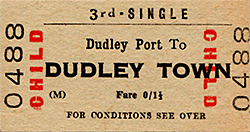 passengers from Dudley, with the Dudley to Walsall, Dudley to Old Hill and the Swan Village to Great Bridge service all listed for withdrawal. The station was also listed for closure, although the Dudley to Dudley Port High Level service was not; it surely could not exist without the station at Dudley - certainly an oversight. Services fell like dominoes, and within four years there was nothing left and that included the station - literally! On 15 June 1964 Dudley’s link with Birmingham Snow Hill via Swan Village closed along with the withdrawal of the Dudley to Old Hill service and Dudley to Walsall. The service to Dudley Port High Level was scheduled to end on the same day, but owing to protests at the withdrawal of the service the end was delayed by three weeks giving time for an omnibus service to take its place. So, on 6 July 1964, the final service to Dudley Port High Level departed, and the station closed, not even two years since the initial withdrawal. Some excursions, to Dudley Zoo, continued to arrive at the ex-LNWR side of the station for a short period, the last documented one being 3 August 1964. passengers from Dudley, with the Dudley to Walsall, Dudley to Old Hill and the Swan Village to Great Bridge service all listed for withdrawal. The station was also listed for closure, although the Dudley to Dudley Port High Level service was not; it surely could not exist without the station at Dudley - certainly an oversight. Services fell like dominoes, and within four years there was nothing left and that included the station - literally! On 15 June 1964 Dudley’s link with Birmingham Snow Hill via Swan Village closed along with the withdrawal of the Dudley to Old Hill service and Dudley to Walsall. The service to Dudley Port High Level was scheduled to end on the same day, but owing to protests at the withdrawal of the service the end was delayed by three weeks giving time for an omnibus service to take its place. So, on 6 July 1964, the final service to Dudley Port High Level departed, and the station closed, not even two years since the initial withdrawal. Some excursions, to Dudley Zoo, continued to arrive at the ex-LNWR side of the station for a short period, the last documented one being 3 August 1964.
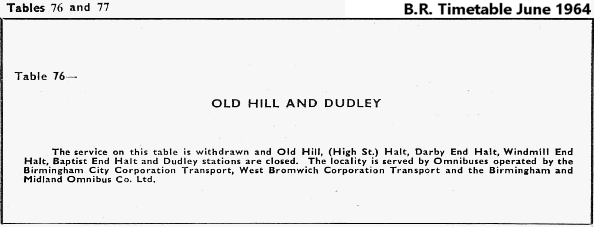
The Reshaping of British Railways also brought a new concept in freight transport to the fore: the ‘liner train’. Containers would be loaded onto block trains which ran from point A to point B, and they could be handled easily by overhead cranes and quickly loaded onto road transport for ‘door-to-door’ delivery and collection of goods. Several of these new liner terminals were to be set up throughout the country and, as the report states, ‘to take advantage of the low cost of fast through train movements as the means of providing trunk haulage over medium to long distances’. Dudley station site was chosen as one of these locations, and in 1967 the entire station was razed to the ground with a two-road terminal constructed and opened by October 1967. The new terminal and many others were an instant success, and business was brisk. Sadly, though, Freightliner had opened a larger and much more accessible terminal at Landor Street, central Birmingham, and although Freightliner attempted to close the Dudley terminal in 1983 it managed to cling on until succumbing during September 1989.
The OWWR line north of the station closed in 1968, although a section was retained as a headshunt for the new terminal, with the southern end becoming part of an important freight route between Bescot yard and South Wales and the West Country, which avoided central Birmingham. The South Staffordshire line also became part of this important freight route which was still busy when closure was announced by British Rail during 1992. BR finally announced that the line would be mothballed during March 1993, and it was severed at its northern section at Bescot Curve Junction and Round Oak at the southern end.
Today it is hard to imagine that the sizeable Dudley station ever existed on the site, partly because of the extensive clearance to make way for the Freightliner terminal. The rails that still run through the site have been re-aligned since the station closed and all traces of the platform have gone. A couple of telegraph insulators are still attached to the retaining wall that holds back the Tipton Road, and a very overgrown ramp runs down from this road to track level. Plans have existed since the line was mothballed in 1993 to reconnect the town of Dudley with the national rail network. It has been rumoured that it will be linked to the Birmingham Metro scheme with trams and freight trains sharing the same route, and a recent plan involved using new GWR- style railcars. It is to be hoped that in the not too distant future Dudley can be restored to the national rail network.
UPDATE May 2021: The railway line through Dudley is scheduled to reopen in 2023 as part of an extension to the West Midlands Metro, although the Metro route will not include the tunnel, it will be used for test purposes by the Very Light Rail National Innovation Centre. The reutilised line will also be designed to carry freight trains.
Tickets from Michael Stewart , route map by Alan Young and Totem from Richad Furness
Sources:
- Railway Reminisences - G P Neele 1904 - Available on the Internet Archive
- Bradshaw's December 1895 Railway Guide - Middleton Press 2011
- By Rail to Halesowen - Michael Hale & Ned Williams - Michael Hale Publishing 1974
- Forgotten Railways: Volume 10 The West Midlands - Rex Christiansen - David St John Thomas Publisher 1985
- A Regional History of the Railways of Great Britain - Volume 7 The West Midlands - Rex Christiansen - David St John Thomas Publisher 1995
- Lost Lines Birmingham & the Black Country - Nigel Welbourn - Ian Allan Publishing - 2002
-
See also:
Blowers Green, Netherton & Old Hill
To see stations along the Bumble Hole click on the station name:
Old Hill High Street Halt, Darby End Halt, Windmill End Halt & Baptist End Halt
|

10.jpg)
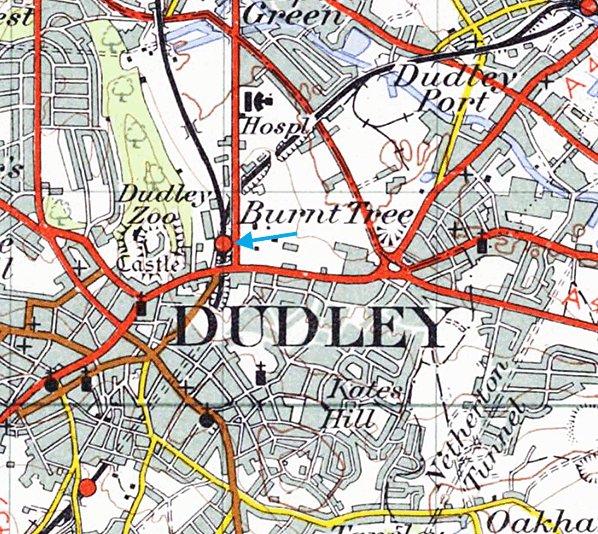
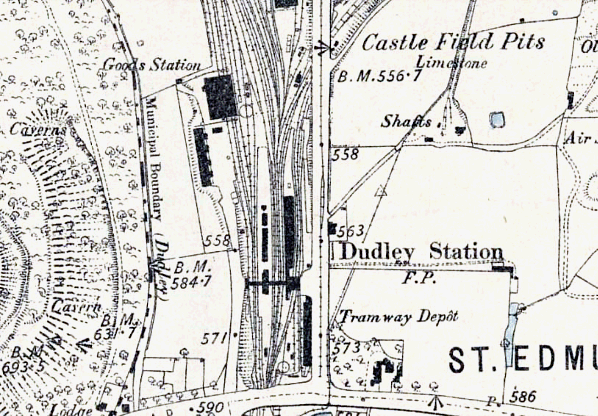
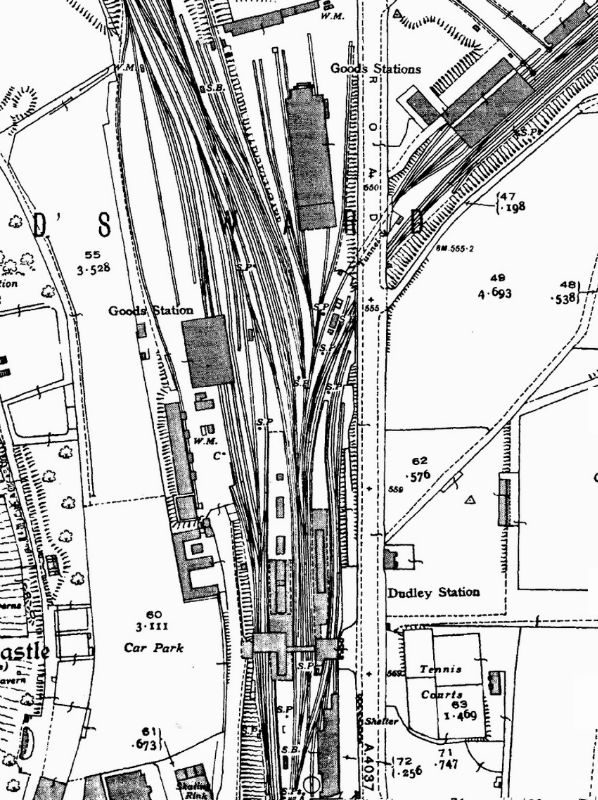
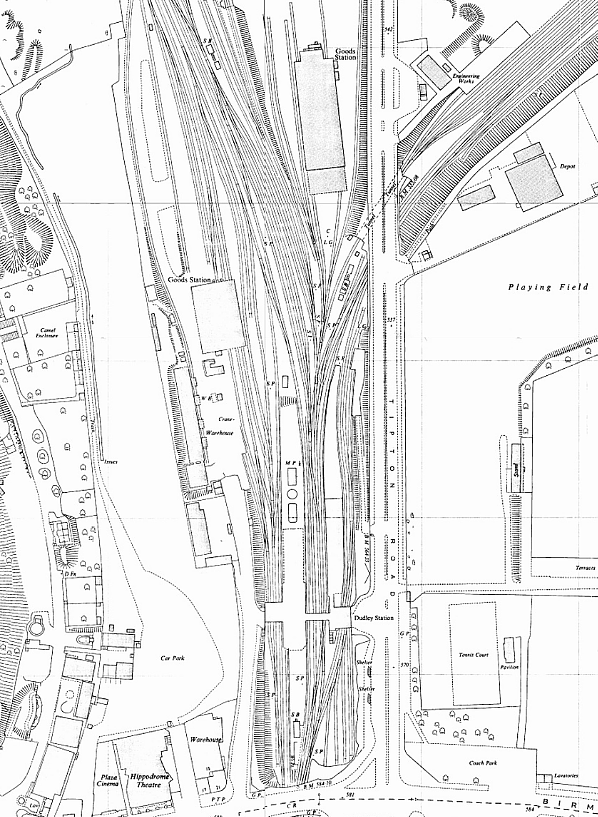 The 1963 OS 1:2500 map shows that some rationalisation has already taken place, with the goods station to the east of the Tipton Road having closed. In early 1967 the station site would be razed to the ground and the Dudley Freightliner terminal would be constructed on the site, being opened in October 1967.
The 1963 OS 1:2500 map shows that some rationalisation has already taken place, with the goods station to the east of the Tipton Road having closed. In early 1967 the station site would be razed to the ground and the Dudley Freightliner terminal would be constructed on the site, being opened in October 1967.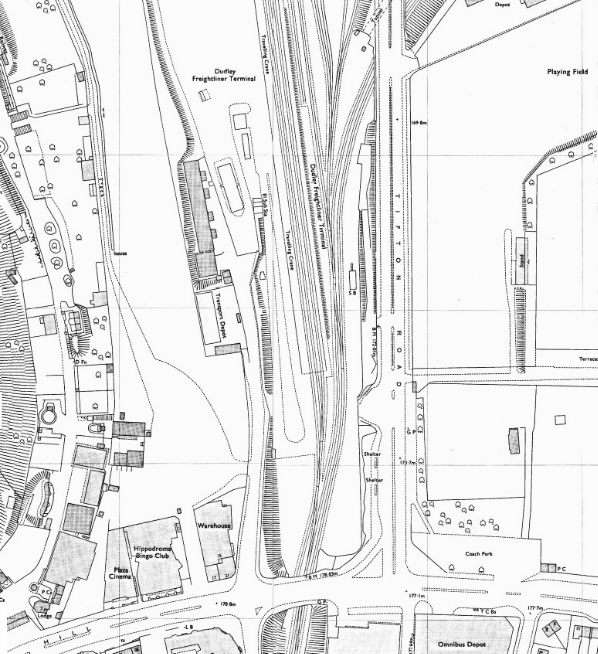
8.jpg)
6.jpg) Looking south along the former GWR island platform during the early 1960s.
Looking south along the former GWR island platform during the early 1960s.7.jpg)
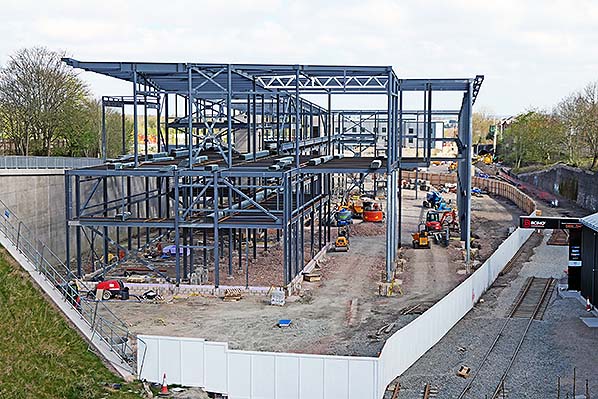


.gif) complete - to a very temporary station: a wooden platform attached to a goods shed. This effectively removed the threat of the BW&DR being given running powers through to Dudley. Goods trains started to use the line on 1 March 1850, with passenger services beginning during May of the same year running to a temporary station near Dudley Castle. The ‘temporary’ station was to become permanent and was developed, by the LNWR, into the station which lasted into the 1960s. The line was leased to John Robinson McClean on 15 July 1850 for a period of 21 years; unusually this lease was completed by an Act of Parliament, the first time an Act was used in this way. McClean developed the lines’ interests to the north with entry gained into the prosperous Cannock coalfield. McClean terminated the lease after 11 years for reasons unknown and this left the LNWR and the MR to fight over ownership of the line; the LNWR won, leasing the line from 1 February 1861.
complete - to a very temporary station: a wooden platform attached to a goods shed. This effectively removed the threat of the BW&DR being given running powers through to Dudley. Goods trains started to use the line on 1 March 1850, with passenger services beginning during May of the same year running to a temporary station near Dudley Castle. The ‘temporary’ station was to become permanent and was developed, by the LNWR, into the station which lasted into the 1960s. The line was leased to John Robinson McClean on 15 July 1850 for a period of 21 years; unusually this lease was completed by an Act of Parliament, the first time an Act was used in this way. McClean developed the lines’ interests to the north with entry gained into the prosperous Cannock coalfield. McClean terminated the lease after 11 years for reasons unknown and this left the LNWR and the MR to fight over ownership of the line; the LNWR won, leasing the line from 1 February 1861..gif) drawn a blank with the GWR for over 12 months he approached the LNWR and the MR to complete the line; it was a step too far for the GWR. No sooner had the LNWR and MR signed the agreement of 21 February 1851 to complete the construction, when the GWR had the agreement declared void in the Court of Chancery and subsequently offered the OW&WR a similar agreement. The Stourbridge to Dudley section was finally completed and opened on 16 November 1852 to goods, and 20 December 1852 to passengers. The line did not reach Wolverhampton until April 1854 for goods and 1 July for passengers. This was mainly due to legal wrangling between the OW&WR and the GWR over the issue of mixed-gauge track running all the way to Wolverhampton and the doubts over the safety of several bridges along the route.
drawn a blank with the GWR for over 12 months he approached the LNWR and the MR to complete the line; it was a step too far for the GWR. No sooner had the LNWR and MR signed the agreement of 21 February 1851 to complete the construction, when the GWR had the agreement declared void in the Court of Chancery and subsequently offered the OW&WR a similar agreement. The Stourbridge to Dudley section was finally completed and opened on 16 November 1852 to goods, and 20 December 1852 to passengers. The line did not reach Wolverhampton until April 1854 for goods and 1 July for passengers. This was mainly due to legal wrangling between the OW&WR and the GWR over the issue of mixed-gauge track running all the way to Wolverhampton and the doubts over the safety of several bridges along the route. 
.gif) passage to America), and to London Paddington and Euston by express train. In the 1930s the LMS had 15 departures to Euston and the GWR 11 both to Paddington and Birkenhead; by 1956 this had altered only slightly with 13 Euston services provided by the London Midland Region (LMR) and 11 Paddington and Birkenhead services on Western Region (WR) lines. The 1854 link from the South Staffordshire line at Sedgeley Junction to Dudley Port High Level saw one of the most intensive services ever, with 70 four-minute journeys in each direction between 6.08am and midnight on weekdays and 20 on Sunday; this was alongside the services to Euston, Birmingham New Street, Burton upon Trent and Walsall.
passage to America), and to London Paddington and Euston by express train. In the 1930s the LMS had 15 departures to Euston and the GWR 11 both to Paddington and Birkenhead; by 1956 this had altered only slightly with 13 Euston services provided by the London Midland Region (LMR) and 11 Paddington and Birkenhead services on Western Region (WR) lines. The 1854 link from the South Staffordshire line at Sedgeley Junction to Dudley Port High Level saw one of the most intensive services ever, with 70 four-minute journeys in each direction between 6.08am and midnight on weekdays and 20 on Sunday; this was alongside the services to Euston, Birmingham New Street, Burton upon Trent and Walsall. passengers from Dudley, with the Dudley to Walsall, Dudley to Old Hill and the Swan Village to Great Bridge service all listed for withdrawal. The station was also listed for closure, although the Dudley to Dudley Port High Level service was not; it surely could not exist without the station at Dudley - certainly an oversight. Services fell like dominoes, and within four years there was nothing left and that included the station - literally! On 15 June 1964 Dudley’s link with Birmingham Snow Hill via Swan Village closed along with the withdrawal of the Dudley to Old Hill service and Dudley to Walsall. The service to Dudley Port High Level was scheduled to end on the same day, but owing to protests at the withdrawal of the service the end was delayed by three weeks giving time for an omnibus service to take its place. So, on 6 July 1964, the final service to Dudley Port High Level departed, and the station closed, not even two years since the initial withdrawal. Some excursions, to Dudley Zoo, continued to arrive at the ex-LNWR side of the station for a short period, the last documented one being 3 August 1964.
passengers from Dudley, with the Dudley to Walsall, Dudley to Old Hill and the Swan Village to Great Bridge service all listed for withdrawal. The station was also listed for closure, although the Dudley to Dudley Port High Level service was not; it surely could not exist without the station at Dudley - certainly an oversight. Services fell like dominoes, and within four years there was nothing left and that included the station - literally! On 15 June 1964 Dudley’s link with Birmingham Snow Hill via Swan Village closed along with the withdrawal of the Dudley to Old Hill service and Dudley to Walsall. The service to Dudley Port High Level was scheduled to end on the same day, but owing to protests at the withdrawal of the service the end was delayed by three weeks giving time for an omnibus service to take its place. So, on 6 July 1964, the final service to Dudley Port High Level departed, and the station closed, not even two years since the initial withdrawal. Some excursions, to Dudley Zoo, continued to arrive at the ex-LNWR side of the station for a short period, the last documented one being 3 August 1964. 
2.jpg) Looking north east at the former LNWR side of the station with a southbound service from Wolverhampton Low Level arriving. The sign on the opposite platform reads ' This Side for New Street Station Birmingham'.
Looking north east at the former LNWR side of the station with a southbound service from Wolverhampton Low Level arriving. The sign on the opposite platform reads ' This Side for New Street Station Birmingham'.3.jpg) Looking north towards Wolverhampton during the 1950s with an ex-GWR Pannier tank simmering away in the bay platform. The GWR and LNWR provided separate ticketing and goods facilities within the station, with the GWR side spanning the former OWWR lines to the left, and the LNWR side spanning the former South Staffordshire lines to the right.
Looking north towards Wolverhampton during the 1950s with an ex-GWR Pannier tank simmering away in the bay platform. The GWR and LNWR provided separate ticketing and goods facilities within the station, with the GWR side spanning the former OWWR lines to the left, and the LNWR side spanning the former South Staffordshire lines to the right.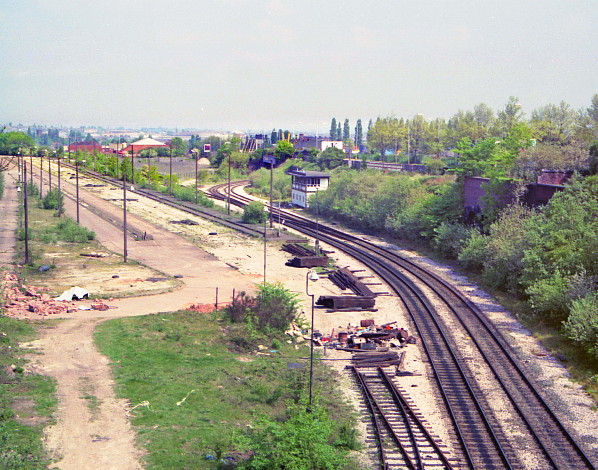 Looking north, again, from Castle Hill road in the early 1990s with the Freightliner terminal having been completely dismantled and the BR LM15 signal box now out of use. By March 1993 the pair of lines seen here would be mothballed by BR even though the line was still a busy freight route which avoided the crowded routes around central Birmingham.
Looking north, again, from Castle Hill road in the early 1990s with the Freightliner terminal having been completely dismantled and the BR LM15 signal box now out of use. By March 1993 the pair of lines seen here would be mothballed by BR even though the line was still a busy freight route which avoided the crowded routes around central Birmingham.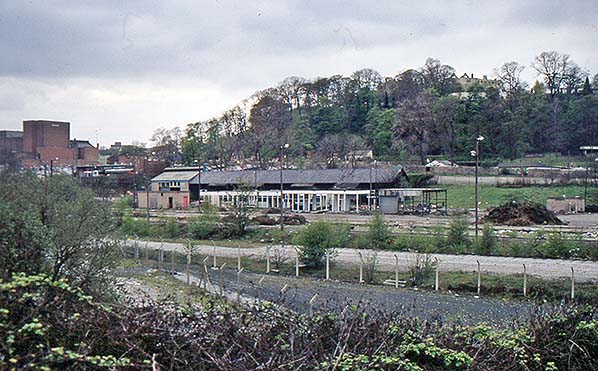
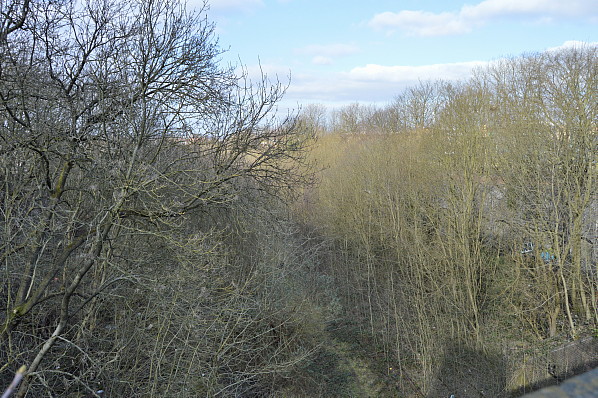 The final of three pictures taken from the same vantage point. This shows the scene on 21 March 2015, with the retaining wall, which has been the reference point for the three pictures, being just visible to the right behind the maturing trees. The two rails running through the site are also visible to the bottom right of the picture.
The final of three pictures taken from the same vantage point. This shows the scene on 21 March 2015, with the retaining wall, which has been the reference point for the three pictures, being just visible to the right behind the maturing trees. The two rails running through the site are also visible to the bottom right of the picture.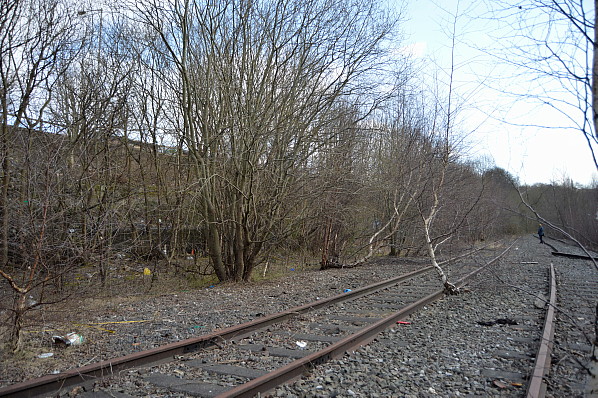 Looking south from the north end of the station site on 21 March 2015. The lines running through the site were realigned when the freightliner terminal was constructed and the station demolished. To the left would have been the LNWR side of the station with the GWR side to the right.
Looking south from the north end of the station site on 21 March 2015. The lines running through the site were realigned when the freightliner terminal was constructed and the station demolished. To the left would have been the LNWR side of the station with the GWR side to the right.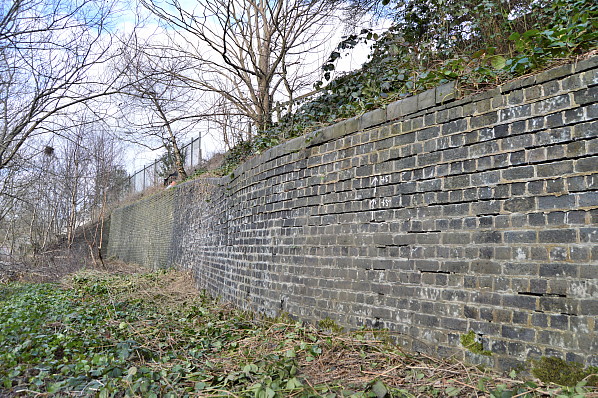
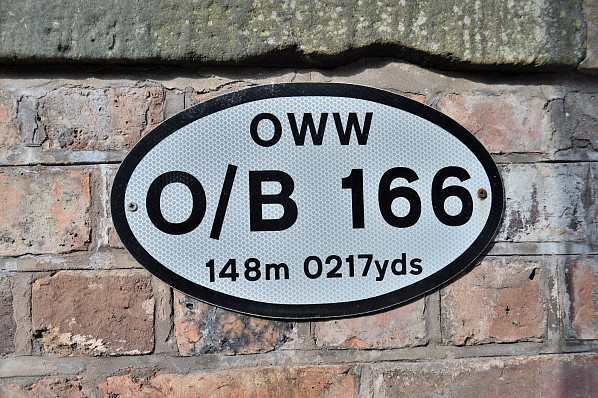 The Oxford, Worcester & Wolverhampton Railway is remembered with this highways sign on the Castle Hill Road overbridge. The bridge marked the boundary of the GWR and LNWR according to the Railway Track Diagrams, with the distance of 148 miles 217 yards being the distance from Paddington via Worcester.
The Oxford, Worcester & Wolverhampton Railway is remembered with this highways sign on the Castle Hill Road overbridge. The bridge marked the boundary of the GWR and LNWR according to the Railway Track Diagrams, with the distance of 148 miles 217 yards being the distance from Paddington via Worcester.
 Home Page
Home Page